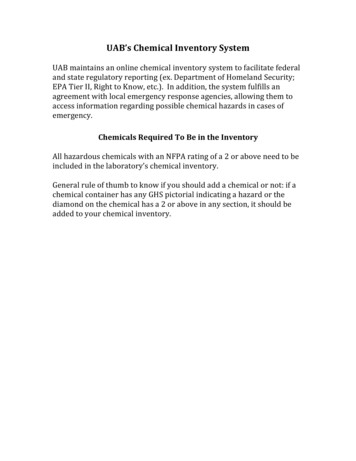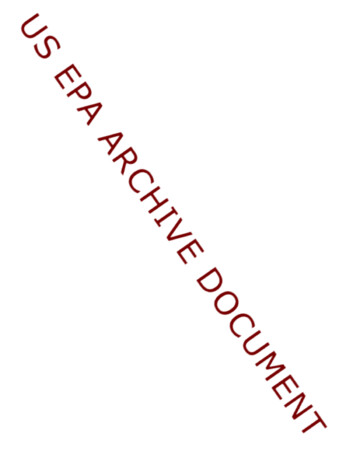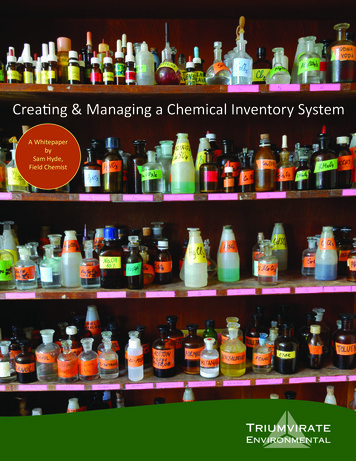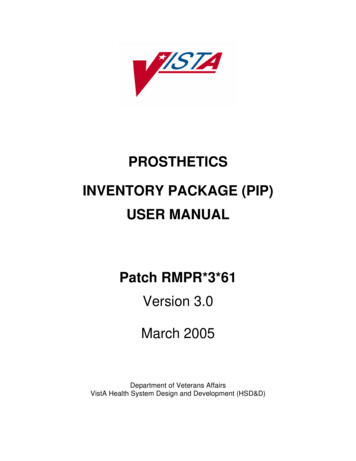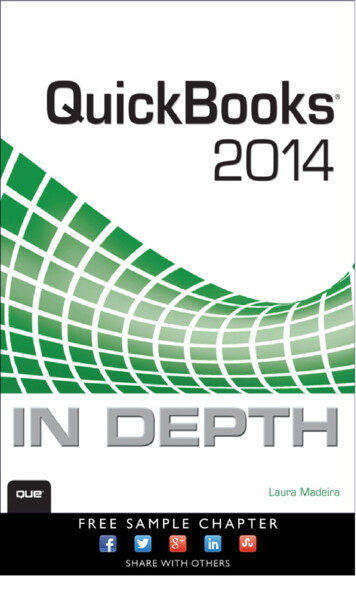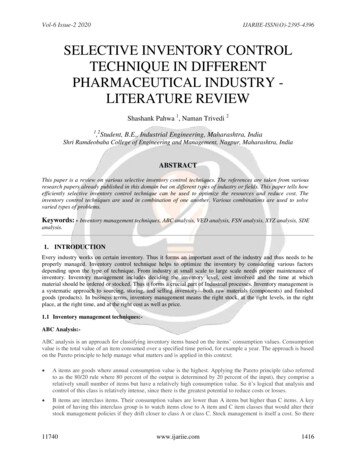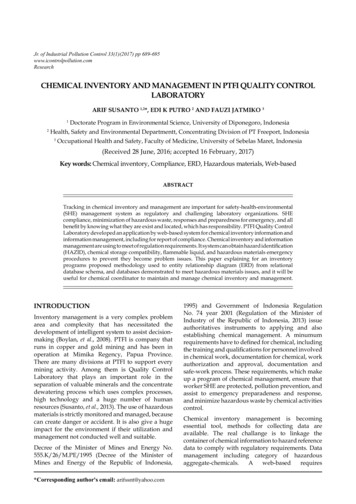
Transcription
Jr. of Industrial Pollution Control 33(1)(2017) pp 689-695www.icontrolpollution.comResearchCHEMICAL INVENTORY AND MANAGEMENT IN PTFI QUALITY CONTROLLABORATORYARIF SUSANTO 1,2*, EDI K PUTRO 2 AND FAUZI JATMIKO 312Doctorate Program in Environmental Science, University of Diponegoro, IndonesiaHealth, Safety and Environmental Departmentt, Concentrating Division of PT Freeport, Indonesia3Occupational Health and Safety, Faculty of Medicine, University of Sebelas Maret, Indonesia(Received 28 June, 2016; accepted 16 February, 2017)Key words: Chemical inventory, Compliance, ERD, Hazardous materials, Web-basedABSTRACTTracking in chemical inventory and management are important for safety-health-environmental(SHE) management system as regulatory and challenging laboratory organizations. SHEcompliance, minimization of hazardous waste, responses and preparedness for emergency, and allbenefit by knowing what they are exist and located, which has responsibility. PTFI Quality ControlLaboratory developed an application by web-based system for chemical inventory information andinformation management, including for report of compliance. Chemical inventory and informationmanagement are using to meet of regulation requirements. It system can obtain hazard identification(HAZID), chemical storage compatibility, flammable liquid, and hazardous materials emergencyprocedures to prevent they become problem issues. This paper explaining for an inventoryprograms proposed methodology used to entity relationship diagram (ERD) from relationaldatabase schema, and databases demonstrated to meet hazardous materials issues, and it will beuseful for chemical coordinator to maintain and manage chemical inventory and management.INTRODUCTIONInventory management is a very complex problemarea and complexity that has necessitated thedevelopment of intelligent system to assist decisionmaking (Boylan, et al., 2008). PTFI is company thatruns in copper and gold mining and has been inoperation at Mimika Regency, Papua Province.There are many divisions at PTFI to support everymining activity. Among them is Quality ControlLaboratory that plays an important role in theseparation of valuable minerals and the concentratedewatering process which uses complex processes,high technology and a huge number of humanresources (Susanto, et al., 2013). The use of hazardousmaterials is strictly monitored and managed, becausecan create danger or accident. It is also give a hugeimpact for the environment if their utilization andmanagement not conducted well and suitable.Decree of the Minister of Mines and Energy No.555.K/26/M.PE/1995 (Decree of the Minister ofMines and Energy of the Republic of Indonesia,*Corresponding author's email: arifssnt@yahoo.com1995) and Government of Indonesia RegulationNo. 74 year 2001 (Regulation of the Minister ofIndustry of the Republic of Indonesia, 2013) issueauthoritatives instruments to applying and alsoestablishing chemical management. A minumumrequirements have to defined for chemical, includingthe training and qualifications for personnel involvedin chemical work, documentation for chemical, workauthorization and approval, documentation andsafe-work process. These requirements, which makeup a program of chemical management, ensure thatworker SHE are protected, pollution prevention, andassist to emergency preparadeness and response,and minimize hazardous waste by chemical activitiescontrol.Chemical inventory management is becomingessential tool, methods for collecting data areavailable. The real challange is to linkage thecontainer of chemical information to hazard referencedata to comply with regulatory requirements. Datamanagement including category of hazardousaggregate-chemicals.Aweb-basedrequires
SUSANTO, ET AL.690Shema of relationaldatabasedatabaseExtractinginformation aboutERDERDInformationInformation Extractioninformation aboutERDExtractinginformation aboutERDFig. 1 Diagram for chemical inventory ERD and database schema in quality control laboratory.only a web browser connected to the ethernet toaccess reference database and a comprehensivemanagement system for identification, reportingand tracking for used of chemicals in quality controllaboratory.METHODOLOGYTwo steps of the methodology: information extractionand ERD (Fig. 1) and observational study. First stepfor information extraction focuses to the attribute,keys, determination of constraint, and done withinformation extraction about ERD from schema ofrelational database, that obtained from a database(Al-Masree, 2016).The observational study is on chemical managementby identifying such factors as: hazard identification,chemical storage, flammable liquid and dangerousmaterials emergency preparadness and responses,and then compared with the standard from UnitedStates Mine Safety and Health Administration(MSHA) Regulations: 30 CFR Subpart C, flammableand combustible liquids and gases; standard AS/NZ3833: the storage and handling of mixed classes ofdangerous goods in packages and intermediate bulkcontainers, and globally harmonized system (GHS)of classification and labeling of chemical.Literature reviewEntity relationship diagram (ERD): Entityrelationship diagram (ERD) is familiar diagram,which aims to present the database structure inconceptualized form. To build good ERD andexcellent schema depends on type of word (verb,noun, adjective, and gerund) (Chen, 1983). The cangenerated from database cause it understandableand simple diagram. Extract ERD schema set froman operational relational database (Xu, et al., 2013).Designers must use tools to reach best implementationof these methodologies by ERDraw to represent ERDand translate to schema of relational database [6].Chemical management: At company with chemicalwork activities, managing inventories of chemicalat laboratory identified as one of SHE managementcompliance. According EPA, institution haveto create and implement a chemical inventoryand management system because the lack of itoperational as a root cause of the complianceproblems encountered [8].A chemical inventory defined as record (writtenand/or electronic) of tracked chemicals at workarea by containment includes the name of chemicalabstract service (CAS) number, manufacturerand information such as the size of container, thematerial in the container, the owner, and the locationby building and room number. In particular, specificactivities will list the chemical used in a chemicalsoperation. Certain chemicals (known humancarcinogens, chemicals of high-acute or high-chronictoxicity, or known human productive toxins) shallbe used in designated areas in which is access isrestricted to authorized personnel [9].Hazards and the situations or circumstances inwhich they could cause harm must be identified andevaluated to determine whether controls are neededto reduce the risk to an acceptable level. Chemicalcompound databases that contain hazard, health,and physical properties with National Fire ProtectionAssociation (NFPA) ratings are commerciallyavailable [8]. Controls must be defined (or developed)and implemented, as needed, to reduce the risksassociated with the work to an acceptable level.The extremely simply user interface; resulted in nowaste of management time for training [10]. Mostchemical inventory systems track chemicals by roomlocation, breaks down location to cabinet and shelf.Storage compatibility fields are used in conjunctionwith storage locations [8].RESULT AND DISCUSSIONChemical inventory entity relational diagramExtracting information process uses the schemaof relational database (Fig. 2) as main input, anddepend to contain data on the table, or depend to
CHEMICAL INVENTORY AND MANAGEMENT IN PTFI QUALITY CONTROL LABORATORY 691CInv Department : (DepartmentID, DepartmentName, DepartmentRootID)CInv Employee : (UID, Name, Email, DepartmentID)CInv Storage : (StorageID, StorageName, StorageDesc, StorageCode, DepartmentID)CInv UsserAccess : (UID, Password, IsAdmin)CInv Container : (ContainerID, ContainerName, ContainerDesc, StorageID)CInv ItemStock : (ItemStockID, ItemID, ContainerID, TotalQuantity, StorageUnit, EntryDate,ExpiryDate, BatchNo, CreatorUID, CreationDate, SDSFile)CInv ItemTransaction : (ItemTransactioID, ItemStockID, Quantity, Remarks, TransactionUID,TransactionDate)CInv Item : (ItemID, ItemName, CASNumber, ItemDesc, ItemCapacity, StorageUnit,ManufacturerID)CInv MeasUnit : (MeasUnit, MeasUnitDesc)CInv SignalClass : (SignalClassID, SignalClassName)CInv ItemDGClass : (ItemID, DGClassID)CInv DGClass : (DGClassID, DGClassName)CInv Manufacturer : (ManufacturerID, ManufacturerName, ManufacturerDesc)CInv ItemHazard : (ItemID, HazardCodeID)CInv HazardCode : (HazardCodeID, HazardCodeDesc)CInv ItemPrecautionary : (ItemID, PrecautionaryCodeID)CInv PrecautionaryCode : (PrecautionaryCodeID, PrecautionaryCodeDesc)Fig. 2 Database relational in quality control laboratory.Fig. 3 Quality control laboratory web-based application.database script code. The first view to the relationaldatabase schema some information becomes clearand on closer examination some important defined.Information contains of database about attributes,entities and relationship between these entities. Fig.3 and 4 presented ERD from database relational andvalidation of the extraction results used by moreadvances rules and based on keywords, and dependon the table that contains data or script code of thedatabase.Chemical inventory and information managementobtain to regulatory implementation concerninghazardous materials. Chemical identifying illustratesthat while chemical work requires a HAZIDdatabase that describe the physical and health issuesassociated with each chemical.The system track storage location to the cabinet withenough specificity to determine whether chemicalsare proper stored as storage requirements, includingstorage compatibility concerns, regulated limits,and proper containers, and containers with morespecificity to shelf make chemicals more easy to find.Regarding the Chemical HAZID database, the valuesentered into these fields must be accurate. As with alltypes of data used in computer-generated reports, thequality of the information being generated dependson the integrity of the information it contains. Even amoderate degree of inaccuracy can erode confidencein system and discourage use.Fig. 3 presented a system of users, owners ofchemical and group. Chemicals are linked within achemical coordinator, and it allows users in differentcategories to access and recall the information toperform their keys responsibilities. For example,quality control department head have access andauthorized to all chemical inventory, reporting andusers administration, and meanwhile a chemicalcoordinator only need the ability to add newinventory and/or delete obsolete inventory. Differentcategories provided varying levels to access andrecall the data and information, based upon theirused and need of the information.Hazard identificationHazard Identification Program signs at laboratorylocations where hazardous materials are used orstored, and should be posted. Many countries havecertain regulation systems for chemical materialslabeling types, requirements and classifications
692SUSANTO, ET AL.Fig. 4 Chemical inventory ERD in quality control laboratory.
CHEMICAL INVENTORY AND MANAGEMENT IN PTFI QUALITY CONTROL LABORATORY 693[10]. However, the differences are quite significantfor classifications, symbols and label, safety datasheets (SDS) of the same products, when they areon markets in many countries. Even in the samecountry, when different controlling authoritiesclose parts of the chemical materials’ life cycles.This causes a protection consistency for those whopotential affected by chemicals, as well as creates awide regulation burdens for companies that producechemical materials [11].For hazard communication (HAZCOM), QualityControl Laboratory used GHS (Fig. 5), while thissystem communicating hazard information inprescribed and uniform way chemical managementshould cover a system where hazardous chemicalmaterials are identified and communicate to allpotentially affected people. These groups includethe workers, customers, emergency respondents,and community. This is also important to know theavailable or used chemical materials, the danger forhuman’s health and environment. Even though theavailable laws and regulations are similar in everycountry [13], they are quite different in terms of theirrequirements and labelling for the same products.Storage compatibilityIncompatibility of stored chemicals is a seriousconcern to prevent an accident, such as containerbreakage, a spill, violent weather events, or a fire.An example of an oxidizing acid being stored with atoxic liquid shown in Fig. 6-7. An effective chemicalinventory system allows you to specify the types ofmaterials that can or cannot be stored in a particularlocation.Fig. 6 Chemical storage cabinet in quality controllaboratory.Fig. 7 Emergency eyewash, drench shower and fire alarmand extinguisher around quality control laboratory.Flammable liquidsFig. 5 GHS classification and symbol.GHS implementation in quality control laboratoryare direct connected to the final objectives andtheir levels of danger. Other labelling elementsare harmonized with the available terms and/orprinciples included in GHS are pictogram (conveyinformation for physical, health, and environmentalhazard); signal words (‘Danger’ or ‘Warning’ used toemphasize hazards); and hazard statement.Based on Fig. 3, describe the flow of chemicalinventory and flow of how to save the chemicalstorage with safe from transaction until saving intostorage. With the chemical inventory web-basedprograms, the laboratory will get easy to do chemicalmaterials inventories, like an input and outputinformation materials, expired date, materialscharacteristic, safety equipment to use, etc.Ten chemical storage requirements consist of keepingquantities of stored flammable and combustibleliquids within regulated limits and within propercontainers. It must be stored in flammable liquidstorage cabinets that listed and approved orconstructed as Section 4-3 of NFPA 30, as shown inFig. 7. In addition, there are limits on the maximumallowable size of containers based on the flammableliquid class. When a query of the field’s chemicalname, amounts, container type, and location wasperformed, the following report was generated(Table 1). Well-managed inventory system canaddress hazard identification, storage compatibility,hazard minimization, and flammable liquid concernsbefore they become issues.Emergency proceduresQuality control laboratory are responsible to identifyand evaluate the hazards, determine for appropriateemergency preparedness and response procedures,
694SUSANTO, ET AL.Table 1. Regulatory compliance report list tableRegulatory Compliance ReportStorageCabinet painted yellow for flammable liquidsCabinet painted blue for corrosive liquidsNo more 60 gallons of flammable liquids and 120 gallons of combustible liquids in one cabinetCabinet doors are to be self-closing, lose fitting, fitted with three-point locking mechanism to secure the doorThe cabinet is fire resistant to a minimum of 10 minutes at 325 F/163 CThe cabinet is to be ventilated and the opening is to be covered by flameproof meshAirflow through the cabinet is sufficient to remove any accumulation of vaporsShelving is designed to assist with ventilatedThe door sill is raised 2 inches above the bottom of the cabinet allowing all leakage to be directed to a lowercontainment section in the bottom of the cabinetThe corrosive storage cabinet is lined with polyethylene linerNo more than 3 cabinets are located in a single storage areaThe location of the cabinet does not impede escape or evacuation in an emergencyCabinet storage outside is positioned in protected areas away from weather and traffic damageIf cabinet is located in buildings, there is secondary egress from that buildingAll containers stored in storage areas have lids/caps fittedNo packing materials such as cardboard boxes and rags are stored inside cabinetNo more than 25 gallon of flammable or combustible liquids is stored outside of an approved storage cabinet, unless thestorage area is designated as a temporary storage areaSymbol and Label, Signage and NoticeMaximum storage capacity signage in liters or gallon must be displayed‘Danger’ or ‘Watch out’ warning sign must be displayedWarning signage of ‘Restricted Area, Authorized Personnel Only’ must be displayedWarning signage of ‘Danger, No Smoking’ within 5 metersAll hazardous material containers will be properly labelledSafety data sheet (SDS) and inventory goods, flammable, combustible are compatible in bilingualCompatibility chart is located on/or near the storage areaEmergency toolsThe cabinet is to have sill 2 inch above the bottom containSpill equipment is availableEmergency eye wash/shower is to be compatible near a storageFirefighting equipment is to be compatible with the class of goods storedand ensure all laboratory staff aware of thoseprocedures. Easy access and ensure to emergencyequipment such as fire alarm and extinguishers,emergency eyewash stations, and showers free toaccessing by laboratory staff (Fig. 7) and sisle spacehave to maintain to ensure that the equipment canreached. Exit signs are equipped with on auxiliarypower emergency lights. Chemical Coordinatorconducts evacuation drills at least once a year andshould evaluate the hazards and quantities of thechemicals in use in their laboratories to determinewhat level of response would be required in theevent of a chemical release [13]. If any incidentwhile chemical releases, fume and/or mist can becontrolled by ventilation and it maintenance willminimizing risk, some releases can pose a fire hazardor health hazard.CONCLUSION AND RECOMMENDATIONChemical inventory web-based programs developedto address hazardous materials issues duringchemical operations and management system canaddress hazard identification, storage compatibility,hazard minimization, and flammable liquid andemergency response and preparedness. Locationsfor containers with specificity to the shelf used toaddress concerning storage and chemical coordinatoraccountability. Chemical Hazard Identificationdatabase provides a way to take advantage of thecombined expertise of the chemical coordinator.The following actions are recommended from thisresearch are conducting labels and signs installmenton storage container which have complied the GHSrequirements and system. Also, withdrawing MSDS(Material Safety Data Sheet) in each storage containerto be replaced with SDS (Safety Data Sheet); repairingcabinet doors and air ventilation in order to complywith the stated standards and requirements; storedthe chemical materials based on their types and
CHEMICAL INVENTORY AND MANAGEMENT IN PTFI QUALITY CONTROL LABORATORY 695cabinet capacity; and put Hazardous MaterialsPlacard in related to firefighting concerns.REFERENCESA guide to the globally harmonized systemof classification and labeling of uideoct05.pdf. Accessed 05/07/16.Al-Masree, H.K. 2015. Extracting entity relationshipdiagram (ERD) from relational database schema.Int. J. Database Theory Appl. (8)3 : 15-26.Boylan, J.E., Syntetos, A.A., Karakostas, G.C. 2008.Classification for forecasting and stock control: Acase study. J. Operational Res. Society. 59 : 473-81.Chen, P.P.S. 1983. English sentence structure andentity-relationship diagrams. J. Inf. Sci. 2 : 127-149.Cournoyer, M.E., Maestas, M.M., Porterfield,D.R. and Spink, P. 2005. Chemical inventorymanagement: The key to controlling hazardousmaterials. Division of chemical health and safetyof the American Chemical Society.Decree of the Minister of Mines and Energy of theRepublic of Indonesia No. 555.K/26/M.PE/1995on Occupational Safety and Health in GeneralMining.Emergency Procedures. y-handbook/iiiemergproc. Accessed 05/07/16.Gibbs, L.M. 2005. ChemTracker Consortium-The highereducation collaboration for chemical inventorymanagement and regulatory reporting. Divisionof Chemical Health and Safety of the AmericanChemical Society.10 GHS Facts in 60 Seconds. er/10-ghs-fact-in60-seconds. Accessed 05/07/16.Kingsley, W.K., Segal, E.B. and Phifer, R. 1998. Livingwith the laboratory standard: Guide for chemicalhygiene officer. American. Chem. Society.Mfourga, N. 1997. Extracting entity-relationshipschemas from relational databases: A form-drivenapproach. Reverse Engineering, Proceeding of theFourth Working Conference on IEEE.Regulation of the Minister of Industry of the Republicof Indonesia No. 23/M-IND/PER/4/2013 onamendment to the regulation of the minister ofindustry No. 87/M-IND/PER/9/2009 on theglobally harmonized system of classification andlabeling of chemicals. 2013.Susanto, A., Suryanegara, D. and Putro, E.K. 2003.Indoor air quality in quality control laboratory,concentrating division PT freeport Indonesia.Proceeding book topic 8. The second internationalconference on sustainable infrastructure and builtenvironment. Faculty of Civil and EnvironmentalEngineering, Institute Teknologi Bandung.Xu, S., Yu, L. and Lu, S. 2003. ERDraw: An XMLbased ER-diagram drawing and translation tool.computers and their applications. 143-146.
Chemical management: At company with chemical work activities, managing inventories of chemical at laboratory identified as one of SHE management compliance. According EPA, institution have to create and implement a chemical inventory and management system because the lack of it operational as a root cause of the compliance problems encountered .
